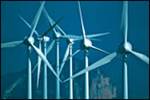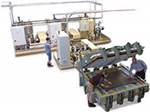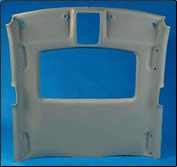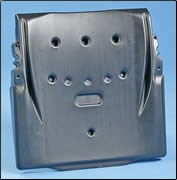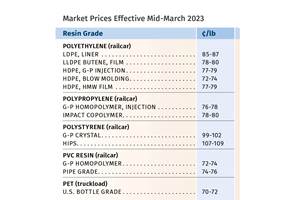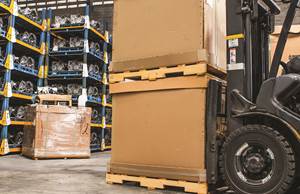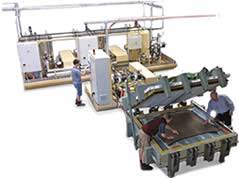Long-Glass Thermoplastics and Blow Molding Grab SPE Automotive Awards
Long-glass reinforcements and structural blow molding accounted for four of this year’s nine SPE Automotive Innovation Awards, presented last month in Detroit.
Long-glass reinforcements and structural blow molding accounted for four of this year’s nine SPE Automotive Innovation Awards, presented last month in Detroit. Seven of the nine winners utilized PP-based materials, including TPOs and TPVs, reflecting the auto industry’s focus on low cost, light weight, and easy recyclability.
From 45 candidates, a committee of the SPE Automotive Div. selected 27 finalists, from which the winners were chosen by a panel of 15 judges from industry, consulting, academia, and trade publications–including Plastics Technology. For a complete list of the winners, not all of which are discussed here, see “Learn More” box.
Long fibers stood out
Eight finalists demonstrated the auto industry’s growing reliance on the superior strength and stiffness of long-fiber reinforcements. One of the most unusual entries, and winner of the Environmental Award, was the headliner of the 2007 Honda Acura MDX. Whereas most headliners are compression molded from glass-mat thermoplastic (GMT) sheet, in this case the long glass was replaced with long fibers of basalt rock (see “Learn More” box). Though heavier and more expensive, basalt fibers provide virtually the same mechanical properties as glass. The reason for using basalt is because it will not contaminate incinerators used to dispose of non-recyclable, end-of-life automotive parts in Japan.
Headliners reportedly contain some 70% of the fiberglass in cars, which melts in an incinerator and sticks to the chamber walls, requiring expensive maintenance. Japan’s Recycling and Treatment Council has legislated that car companies must repay those incinerator cleanup costs.
The formable polypropylene/basalt sheet is a new product called VolcaLite from Azdel Inc. (marketed by GE Plastics). The headliner is molded by M-Tek, Inc., Manchester, Tenn.
Also interesting is the first appearance among these awards of long-glass parts made by a direct long-fiber thermoplastic (D-LFT) process. Winner of the Body Interior category was an instrument-panel (IP) structural duct assembly for the 2007 Dodge Nitro SUV. The structural duct of 30% long-glass PP, which is vibration welded to a talc-filled TPO IP retainer, eliminates the need for a metal cross-car beam, saving weight and cost. Long-glass PP also has twice the stiffness of the more expensive (and 7% heavier) PC/ABS it replaced, pushing total assembly cost savings up to 15%. This duct will also be used on the 2008 Jeep Liberty KK.
Adding interest is the fact that this part was molded on a Krauss-Maffei Injection Molding Compounder (IMC), a machine that mounts a twin-screw extruder over the plunger of a two-stage molding press. The twin-screw pulls in continuous strands of glass, mixes and wets them with PP, coupling agent, black concentrate, and regrind before feeding it to the injection plunger. An accumulator permits the extruder to operate continuously.
The part was molded using a very high-flow (60 MFR) PP copolymer (Pro-fax SG853 from Basell) so that the final mix has a 20 MFR. According to the Tier 1 molder, Intertec Systems, St. Mary’s, Ont., the glass length entering the mold is 20 to 25 mm and fibers in the molded part average 8 mm. Thus, IMC reportedly provides twice the tensile strength and higher elongation than would be provided by precompounded long-glass pellets with a typical glass length of 4 to 5 mm–even at a higher loading (40%). Intertec also claims twice the impact resistance of short-glass PP and more than twice the stiffness of the PC/ABS previously used. Because the material is compounded in the press, DaimlerChrysler and Intertec developed something new–a material specification based on the molded part, not the raw material.
There was a second finalist this year that used the Krauss-Maffei IMC technology to compound long-glass PP on the press. This was the one-piece inner door hardware module and structural reinforcement for the 2007 Chrysler Sebring sedan. This 40% glass-filled part eliminates 11 separate subassemblies, including a stamped metal reinforcement. An integral armrest support is designed to collapse on side impact. Injection-compression molding yields a 2-mm wall thickness and 12-mm glass length in the final part, according to the molder, Intier Automotive Interiors, sub. of Magna International, Novi, Mich.
Five other finalists were injection molded from long-glass pellets:
- Mercedes-Benz M-, R-, and GL-Class cars sport the first use of 30% long-glass PP in large injection molded IP retainers. They were molded by Delphi Corp. in Gadsden, Ala., using 13-mm StaMax pellets from SABIC Europe, Sittard, Netherlands. (SABIC licensed RheTech in the U.S. to make a similar product under the name RheMax.) Delphi used this material in place of SMA, PC, or PC/ABS. Wall thickness is 1.8 mm, and the area around the seamless airbag door is even thinner.
- The front-end carrier for the Jeep Wrangler has two side pieces of 40% long-glass PP (Ticona’s Celstran) joined to steel bars on the top and bottom. The parts are bonded with Dow’s Betamate LESA structural adhesive, which requires no primer or surface preparation. The assembly is produced by Decoma International, Concord, Ont.
- Both the Body Exterior category and Grand Award went to the blow molded TPO front and rear structural bumpers on the 2007 Jeep JK. The all-plastic structural window frame on the 2007 Jeep Wrangler is molded for Decoma by Nyloncraft, Inc., Mishawaka, Ind., using Ticona’s Celstran 40% long-glass/PP pellets.
- The PP carrier for the first window-glass regulator that does not have a steel rail is molded by Faurecia Interior Systems in Frazier, Mich., for the 2007 Dodge Nitro. Faurecia blends Twintex 75% long-glass pellet concentrate from Saint-Gobain Vetrotex America with virgin PP at the press to achieve 25% glass content in the part.
- The lower bumper stiffener for pedestrian protection on the 2006 Opel Corsa is molded of 30% long-glass nylon 6 (BASF Ultramid B3WG6 CR) by Heyco in Germany. BASF developed new proprietary software that translates the fiber orientation in the part–predicted by mold-filling simulation–into mechanical properties determined by finite-element structural analysis.
Blow molding starred
Both the Body Exterior Award and the Grand Award this year went to the front and rear bumpers for the 2007 Jeep JK. They are blow molded of a special TPO (Salflex 610MW RXF) compounded by Salflex Polymers, part of ABC Group, Toronto, another branch of which molded the bumpers. These are structural parts with a non-painted, textured, Class A surface. They were chosen in place of a conventional system with an injection molded cover and injection molded honeycomb energy absorber, but the blow molded versions retain the steel support beam. The plastic portion weighs 11 to 15 lb. They meet European requirements for pedestrian impact protection, withstand a 300-lb step-load test, and are said to have exceptional grain quality for such large blow molded parts.
Winner of the Safety category was the fully structural blow molded seat back for the 2007 Audi TT sedan. These unusual free-standing rear seats were molded of Dow’s Pulse 2200 BG PC/ABS for Lear Corp. by Moellertech GmbH in Bielefeld, Germany. The ribbed part replaces a steel frame and sheet metal. The mold includes protrusions that form tack-offs to enhance stiffness.
Although not a winner, one of the most interesting finalists was a blow molded load floor of talc-filled PP with an insert-molded, non-slip TPO surface. This part was molded for the 2006 Dodge Caliber SUV and Jeep Compass and Patriot by Lear Corp., Fremont, Ohio. A 2- to 3-mm TPO sheet with an embossed grain pattern is precut and inserted into the mold before the parison is extruded and blown behind the sheet. The sheet is specially treated to make it porous so that air is eliminated between the TPO sheet and PP parison, allowing them to bond securely without any adhesive. The part has internal ribs for stiffness so that it can support a 250-lb load and also has a living hinge to allow access to the under-floor spare tire. The one-step insert blow molding process substitutes for the use of carpet, which requires adhesive and additional process steps.
Related Content
Prices of Volume Resins Generally Flat or Lower
Exceptions in early March were PP and PS, which moved up solely due to feedstock constraints, along with slight upward movement in PVC and PET.
Read MoreScaling Up Sustainable Solutions for Fiber Reinforced Composite Materials
Oak Ridge National Laboratory's Sustainable Manufacturing Technologies Group helps industrial partners tackle the sustainability challenges presented by fiber-reinforced composite materials.
Read MoreThe Fantasy and Reality of Raw Material Shelf Life: Part 1
Is a two-year-old hygroscopic resin kept in its original packaging still useful? Let’s try to answer that question and clear up some misconceptions.
Read MoreNPE2024 Materials: Spotlight on Sustainability with Performance
Across the show, sustainability ruled in new materials technology, from polyolefins and engineering resins to biobased materials.
Read MoreRead Next
Composites--Part II: Winds of Change Stir Materials R&D
Part II of our review of the big composites show in Paris focuses on news in materials and reinforcements. They include lighter, stronger reinforcements for large parts such as wind blades and growing inroads by thermoplastics to speed up production.
Read MoreComposites: New Rapid Molding Technologies and Unusual Reinforcements at Paris JEC Show
New molding technologies seen at the JEC Composites Show in Paris in April promise dramatically faster cycles than are achievable with autoclaves or RTM. One novel technique rapidly heats and cools a thin tool by "floating" it on a flexible bladder—similar to a water bed—that is flooded with heat-transfer fluid.
Read MoreD-LFT Composites Aim for Auto Body Panels
Direct long-fiber thermoplastic (D-LFT) compounding and molding is getting ready to expand beyond non-appearance structural automotive parts to exterior body panels.
Read More

